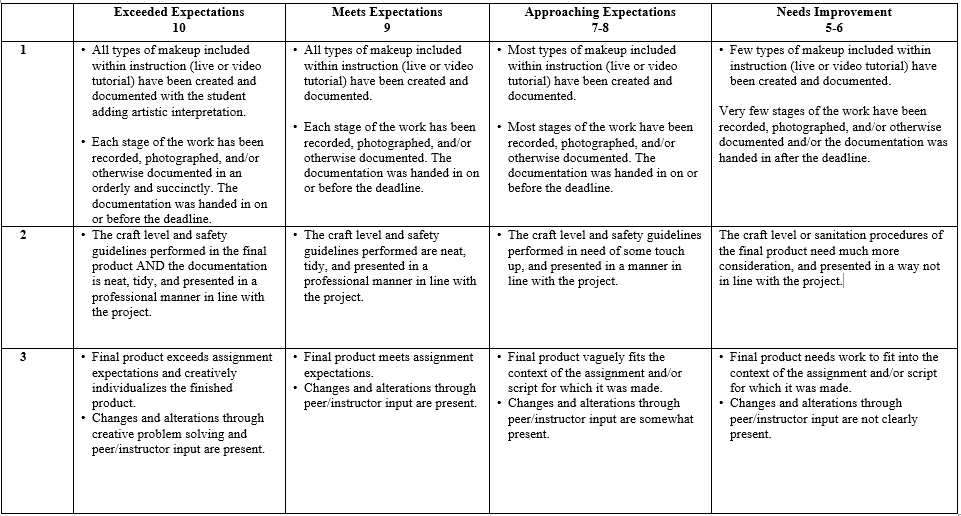
Click to Teach/Click to Learn: The Painted Mask - Non-Prosthetic Makeup Effects and Design
Created by Jason Robert LeClair
In a vast variety of ways, theatrical makeup can be used to create almost any illusion for the stage. This lesson will also cover designing fantasy makeup for Cyborgs, Fairies, and Mythical Creatures. Using the same techniques as are in the tutorials, you can make any design come to life!
Learning Outcomes:
- Students will learn the basic principles of creating effects with cream based makeup, water activated body paint, and common eyeshadows.
- Students will learn the proper method of safe and sterile work with makeup.
- Students will learn techniques of painting effects on faces with proper materials
Students will be able to:
- Create a myriad of designs using the methods highlighted in the tutorials
- Accomplish stage effects with makeup for various size stages
- Determine what colors work for what effects
- Create characters using makeup to accentuate an actor’s performance
Step 1: Get Inspired
Masks come in all shapes and sizes and since the Greek theatre have been used to define character. One of the methods we use now is painting our masks directly onto our faces. It allows for the expression of the actor to shine through rather than be hidden behind a structure.
Check out this example below that makes use of UV paint to glow in blacklight.
Step 2: Sketching Makeup Designs
Watch the following video tutorials.Take active and thorough notes on the design lessons.
Creature Makeup
Cyborg Makeup
Fairy Makeup
Step 3: Safety
Watch and take notes on the following videos on safety.
Step 4: Makeup Tutorials
Watch and take notes on at least two of the following videos on basic cuts, bruises, and aging for different complexions.
For a more in-depth look at applying make up for darker skin tones, check out this workshop with make up artist Destinee Steele available right here on EdTA's Learning Center.
Cuts and Scars
Bruises
Old Age Stage Make-up
Step 5: Design & Get Feedback
DESIGN - Students will individually design on paper two to three faces to try on themselves or someone in their household. (You can utilize any script, but I have found A Midsummer Night’s Dream to have a wide scope of possibilities for this exercise).
SHARE - Students will post pictures and a list of procedures (or a video) on how the look was accomplished to the Learning Management System your school uses (Google Classroom, Canvas, etc.).
FEEDBACK - Students should give peer feedback in writing using the following guidelines: Comment on your peers' work and always use constructive criticism. Constructive criticism answers WHY you like something or think it needs work. It is a way for us as artists to see things from another viewpoint.
- "I like it, because..."
- "Why did you make the decision to...."
- "This portion/piece doesn't work for me because..."
- "This portion/piece is outstanding because..."
- etc.
Step 6: Application
REVISE - Students are invited to make revisions to their designs based on any feedback received.
Next, students should apply the makeup following the safety protocols to themselves or a member of their household.
SHARE - Post pictures and a list of procedures (or a video) on how the look was accomplished to the Learning Management System your school uses (Google Classroom, Canvas, etc.).
FEEDBACK - Give peer feedback in writing using the constructive criticism guidelines in step 5.
Step 7: Presentation
Students will create a slide presentation on the final product reflecting in the slides on the following questions:
- What was the process you used to accomplish this design and application?
- What were some of the successes you had along the way? Cite peer feedback.
- What were some challenges you had along the way? Cite peer feedback
- Do you feel that the design portrayed the character? Why?
Diving Deeper
Want to know more about a makeup designer's work? Watch the following video to learn about the experiences of two professional makeup designers.
Measuring Learning
VIEW (PDF) or DOWNLOAD AND CUSTOMIZE (Word doc) the Painted Mask Rubric

Classroom Connections
High School Proficient
TH:Cr2.1.I.b. Investigate the collaborative nature of the actor, director, playwright, and designers and explore their interdependent roles in a drama/theatre work.
TH:Pr4.1.I.a Examine how character relationships assist in telling the story of a drama/theatre work.
TH:Cn11.2.I.a. Research how other theatre artists apply creative processes to tell stories in a devised or scripted drama/theatre work, using theatre research methods.
| Access Date | Quiz Result | Score | Actions |
|---|
Learning Center
- Webinars
- Adjudication Trainings
- Featured Courses
- Full Course List
- Lesson Plan Library
- Click to Teach Interactive Online Lessons
- Resources for New Theatre Teachers
- Technical Theatre Educator's Manual
- Connected Arts Networks
- Diverse Resources for Theatre Education
- Behind the Scenes Technical Theatre Curriculum
- Social & Emotional Learning
- Additional Standards Based Instructional Resources
- Search the Catalog
- Cart (0 items)
Full Site Search
Membership Benefits
Join EdTA for full access to our professional development and standards-based teaching resources, including:
- 300+ lesson plans
- Click to Teach online lessons
- K-12 curriculum
- Webinars
- And more!




